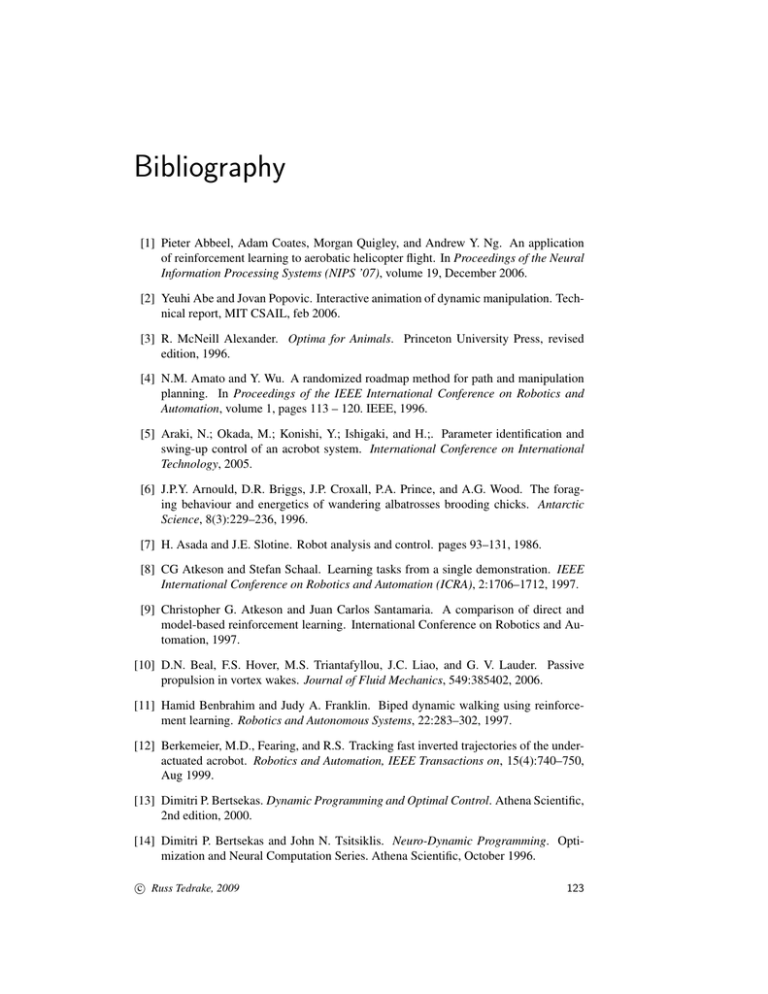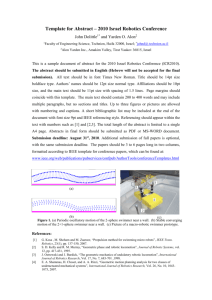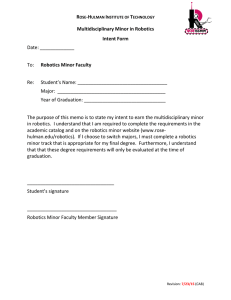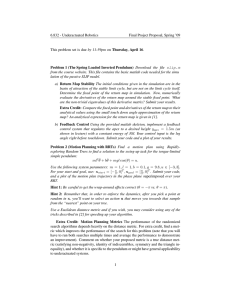Bibliography
advertisement

Bibliography [1] Pieter Abbeel, Adam Coates, Morgan Quigley, and Andrew Y. Ng. An application of reinforcement learning to aerobatic helicopter flight. In Proceedings of the Neural Information Processing Systems (NIPS ’07), volume 19, December 2006. [2] Yeuhi Abe and Jovan Popovic. Interactive animation of dynamic manipulation. Tech­ nical report, MIT CSAIL, feb 2006. [3] R. McNeill Alexander. Optima for Animals. Princeton University Press, revised edition, 1996. [4] N.M. Amato and Y. Wu. A randomized roadmap method for path and manipulation planning. In Proceedings of the IEEE International Conference on Robotics and Automation, volume 1, pages 113 – 120. IEEE, 1996. [5] Araki, N.; Okada, M.; Konishi, Y.; Ishigaki, and H.;. Parameter identification and swing-up control of an acrobot system. International Conference on International Technology, 2005. [6] J.P.Y. Arnould, D.R. Briggs, J.P. Croxall, P.A. Prince, and A.G. Wood. The forag­ ing behaviour and energetics of wandering albatrosses brooding chicks. Antarctic Science, 8(3):229–236, 1996. [7] H. Asada and J.E. Slotine. Robot analysis and control. pages 93–131, 1986. [8] CG Atkeson and Stefan Schaal. Learning tasks from a single demonstration. IEEE International Conference on Robotics and Automation (ICRA), 2:1706–1712, 1997. [9] Christopher G. Atkeson and Juan Carlos Santamaria. A comparison of direct and model-based reinforcement learning. International Conference on Robotics and Au­ tomation, 1997. [10] D.N. Beal, F.S. Hover, M.S. Triantafyllou, J.C. Liao, and G. V. Lauder. Passive propulsion in vortex wakes. Journal of Fluid Mechanics, 549:385402, 2006. [11] Hamid Benbrahim and Judy A. Franklin. Biped dynamic walking using reinforce­ ment learning. Robotics and Autonomous Systems, 22:283–302, 1997. [12] Berkemeier, M.D., Fearing, and R.S. Tracking fast inverted trajectories of the underactuated acrobot. Robotics and Automation, IEEE Transactions on, 15(4):740–750, Aug 1999. [13] Dimitri P. Bertsekas. Dynamic Programming and Optimal Control. Athena Scientific, 2nd edition, 2000. [14] Dimitri P. Bertsekas and John N. Tsitsiklis. Neuro-Dynamic Programming. Opti­ mization and Neural Computation Series. Athena Scientific, October 1996. c Russ Tedrake, 2009 � 123 124 BIBLIOGRAPHY [15] Dimitri P. Bertsekas and John N. Tsitsiklis. Introduction to Probability. Unpublished class notes edition, 2000. [16] John T. Betts. Practical Methods for Optimal Control Using Nonlinear Program­ ming. SIAM Advances in Design and Control. Society for Industrial and Applied Mathematics, 2001. [17] A. Bicchi. Hands for dextrous manipulation and robust grasping: a difficult road towards simplicity. IEEE Transactions on Robotics and Automation, 16(6):652–662, December 2000. [18] Antonio Bicchi. On the closure properties of robotic grasping. International Journal of Robotics Research, 14(4):319–334, 1995. [19] Alec Brooks and Paul MacCready. Development of a wing-flapping flying replica of the largest pterosaur. In AIAA/SAE/ASME/ASEE 21st Joint Propulsion Conference. AIAA, July 1985. [20] R. R. Burridge, A. A. Rizzi, and D. E. Koditschek. Sequential composition of dy­ namically dexterous robot behaviors. International Journal of Robotics Research, 18(6):534–555, June 1999. [21] Chi-Tsong Chen. Linear System Theory and Design. Oxford Series in Electrical and Computer Engineering. Oxford University Press, third edition, Sept 10 1998. [22] Stephen Childress. Mechanics of swimming and flying. Cambridge University Press, 1981. [23] Chung Choo Chung and John Hauser. Nonlinear control of a swinging pendulum. Automatica, 31(6):851–862, June 1995. [24] Michael J. Coleman. A Stability-Study of a Three-Dimensional Passive-Dynamic Model of Human Gait. PhD thesis, Cornell University, 1998. [25] Steven H. Collins, Andy Ruina, Russ Tedrake, and Martijn Wisse. Efficient bipedal robots based on passive-dynamic walkers. Science, 307:1082–1085, February 18 2005. [26] Steven H. Collins, Martijn Wisse, and Andy Ruina. A three-dimensional passivedynamic walking robot with two legs and knees. International Journal of Robotics Research, 20(7):607–615, July 2001. [27] John Craig. Introduction to Robotics: Mechanics and Control. Addison Wesley, 2nd edition, January 1989. [28] Michael H. Dickinson, Fritz-Olaf Lehmann, and Sanjay P. Sane. Wing rotation and the aerodynamic basis of insect flight. Science, 284(5422):1954–60, June 1999. [29] Charles P. Ellington, Coen van den Berg, Alexander P. Willmott, and Adrian L. R. Thomas. Leading-edge vortices in insect flight. Nature, 384(19):626–630, December 1996. c Russ Tedrake, 2009 � BIBLIOGRAPHY 125 [30] Isabelle Fantoni and Rogelio Lozano. Non-linear Control for Underactuated Me­ chanical Systems. Communications and Control Engineering Series. Springer-Verlag, 2002. [31] Ila Rani Fiete. Learning and coding in biological neural networks. PhD thesis, 2003. [32] IR Fiete, RH Hahnloser, MS Fee, and HS Seung. Temporal sparseness of the premotor drive is important for rapid learning in a neural network model of birdsong. J Neurophysiol., 92(4):2274–82. Epub 2004 Apr 07., Oct 2004. [33] R.J. Full and D.E. Koditschek. Templates and anchors: neuromechanical hypotheses of legged locomotion on land. Journal of Experimental Biology, 202(23):3325–3332, 1999. [34] Hartmut Geyer. Simple models of legged locomotion based on compliant limb behav­ ior. PhD thesis, University of Jena, 2005. [35] Herbert Goldstein. Classical Mechanics. Addison Wesley, 3rd edition, 2002. [36] A. Goswami. Postural stability of biped robots and the foot rotation indicator (FRI) point. International Journal of Robotics Research, 18(6), 1999. [37] Ambarish Goswami, Benoit Thuilot, and Bernard Espiau. Compass-like biped robot part I : Stability and bifurcation of passive gaits. Technical Report RR-2996, INRIA, October 1996. [38] Kenneth C. Hall and Steven A. Pigott. Power requirements for large-amplitude flap­ ping flight. Journal of Aircraft, 35(3), May 1998. [39] Philip Holmes, Robert J. Full, Dan Koditschek, and John Guckenheimer. The dynam­ ics of legged locomotion: Models, analyses, and challenges. Society for Industrial and Applied Mathematics (SIAM) Review, 48(2):207–304, 2006. [40] David Hsu, Robert Kindel, Jean-Claude Latombe, and Stephen Rock. Randomized kinodynamic motion planning with moving obstacles. The International Journal of Robotics Research, 21(3):233–255, 2002. [41] Vanessa Hsu. Passive dynamic walking with knees: A point-foot model. Master’s thesis, Massachusetts Institute of Technology, February 2007. [42] David H. Jacobson and David Q. Mayne. Differential Dynamic Programming. Amer­ ican Elsevier Publishing Company, Inc., 1970. [43] L.E. Kavraki, P. Svestka, JC Latombe, and M.H. Overmars. Probabilistic roadmaps for path planning in high-dimensional configuration spaces. IEEE Transactions on Robotics and Automation, 12(4):566–580, August 1996. [44] Daniel E. Koditschek and Martin Buehler. Analysis of a simplified hopping robot. International Journal of Robotics Research, 10(6):587–605, Dec 1991. [45] N. Kohl and P. Stone. Machine learning for fast quadrupedal locomotion, July 2004. c Russ Tedrake, 2009 � 126 BIBLIOGRAPHY [46] Nate Kohl and Peter Stone. Policy gradient reinforcement learning for fast quadrupedal locomotion. In Proceedings of the IEEE International Conference on Robotics and Automation (ICRA), 2004. [47] V. R. Konda and J. N. Tsitsiklis. Actor-critic algorithms. SIAM Journal on Control and Optimization, 42(4):1143–1166, 2003. [48] Andrew L. Kun and W. Thomas Miller, III. Adaptive dynamic balance of a biped robot using neural networks. In Proceedings of the IEEE International Conference on Robotics and Automation (ICRA), pages 240–245, 1996. [49] Xu-Zhi Lai, Jin-Hua She, Simon X. Yang, and Min Wu. Stability analysis and control law design for acrobots. In Proceedings of the 2006 IEEE International Conference on Robotics and Automation, May 2006. [50] S. LaValle and J. Kuffner. Rapidly-exploring random trees: Progress and prospects. In Proceedings of the Workshop on the Algorithmic Foundations of Robotics, 2000. [51] Steven M. LaValle. Planning Algorithms. Cambridge University Press, 2006. [52] Steven M. LaValle, James J. Kuffner, and Jr. Randomized kinodynamic planning. The International Journal of Robotics Research, 20(5):378–400, 2001. [53] James C. Liao, David N. Beal, George V. Lauder, and Michael S. Triantafyllou. The Kármán gait: novel body kinematics of rainbow trout swimming in a vortex street. Journal of Experimental Biology, 206(6):1059–1073, 2003. [54] Arun D. Mahindrakar and Ravi N. Banavar. A swing-up of the acrobot based on a simple pendulum strategy. International Journal of Control, 78(6):424–429, April 2005. [55] Tad McGeer. Passive dynamic walking. International Journal of Robotics Research, 9(2):62–82, April 1990. [56] Thomas A. McMahon and George C. Cheng. The mechanics of running: How does stiffness couple w/ speed. Journal of Biomechanics, 23(Supplement 1):65–78, 1990. [57] W. Thomas Miller, III. Real-time neural network control of a biped walking robot. IEEE Control Systems Magazine, 14(1):41–48, Feb 1994. [58] Simon Mochon and Thomas A. McMahon. Ballistic walking. Journal of Biomechan­ ics, 13:49–57, 1980. [59] Simon Mochon and Thomas A. McMahon. Ballistic walking: An improved model. Mathematical Biosciences, 52(3-4):241–260, December 1980. [60] Jun Morimoto and Kenji Doya. Reinforcement learning of dynamic motor sequence: Learning to stand up. pages 1721–1726. IEEE/RSJ International, 1998. [61] Richard M. Murray and John Hauser. A case study in approximate linearization: The acrobot example, April 1991. c Russ Tedrake, 2009 � BIBLIOGRAPHY 127 [62] Richard M. Murray, Zexiang Li, and S. Shankar Sastry. A Mathematical Introduction to Robotic Manipulation. CRC Press, Inc., 1994. [63] Eadweard Muybridge and Anita Ventura Mozley. Muybridge’s Complete Human and Animal Locomotion: All 781 Plates from the 1887 Animal Locomotion. 3 Vols. Dover Publications, Incorporated, May 1979. [64] Andrew Y. Ng, H. Jin Kim, Michael I. Jordan, and Shankar Sastry. Autonomous heli­ copter flight via reinforcement learning. Advances in Neural Information Processing Systems (NIPS), 16, 2003. [65] Katsuhiko Ogata. Modern Control Engineering. Prentice Hall Incorporated, 3rd edition, August 1996. [66] Barak Pearlmutter. Learning state space trajectories in recurrent neural networks. Neural Computation, 1:263–9, 1989. [67] William H. Press, Saul A. Teukolsky, William T. Vetterling, and Brian P. Flannery. Numerical Recipes in C: The Art of Scientific Computing. Cambridge University Press, second edition, 1992. [68] Marc H. Raibert. Legged Robots That Balance. The MIT Press, 1986. [69] Stefan Schaal and Chris Atkeson. Robot juggling: An implementation of memorybased learning. (14):57–71. [70] W Schultz. Getting formal with dopamine and reward. Neuron., 36(2):241–63., Oct 10 2002. [71] H. Sebastian Seung, Daniel D. Lee, Ben Y. Reis, and David W. Tank. The autapse: a simple illustration of short-term analog memory storage by tuned synaptic feedback. Journal of Computational Neuroscience, 9:171–85, 2000. [72] Sebastian Seung. The REINFORCE algorithm. 2001. [73] Wei Shyy, Yongsheng Lian, Jian Teng, Dragos Viieru, and Hao Liu. Aerodynamics of Low Reynolds Number Flyers. Cambridge Aerospace Series. Cambridge University Press, 2008. [74] Athanasios Sideris and James E. Bobrow. A fast sequential linear quadratic algorithm for solving unconstrained nonlinear optimal control problems, February 2005. [75] Jean-Jacques E. Slotine and Weiping Li. Applied Nonlinear Control. Prentice Hall, October 1990. [76] M. W. Spong. Underactuated mechanical systems. In B. Siciliano and K. P. Valavanis, editors, Control Problems in Robotics and Automation, Lecture notes in control and information sciences 230. Springer-Verlag, 1997. [77] Mark Spong. The swingup control problem for the acrobot. IEEE Control Systems Magazine, 15(1):49–55, February 1995. c Russ Tedrake, 2009 � 128 BIBLIOGRAPHY [78] Mark W. Spong. Partial feedback linearization of underactuated mechanical systems. In Proceedings of the IEEE International Conference on Intelligent Robots and Sys­ tems, volume 1, pages 314–321, September 1994. [79] Mark W. Spong. Swing up control of the acrobot. In Proceedings of the IEEE Inter­ national Conference on Robotics and Automation (ICRA), pages 2356–2361, 1994. [80] Mark W. Spong. Energy based control of a class of underactuated mechanical sys­ tems. In Proceedings of the 1996 IFAC World Congress, 1996. [81] Mark W. Spong and Gagandeep Bhatia. Further results on control of the compass gait biped. In Proc. IEEE International Conference on Intelligent Robots and Systems (IROS), pages 1933–1938, 2003. [82] Gilbert Strang. Introduction to Linear Algebra. Wellesley-Cambridge Press, 2nd edition, October 1998. [83] Steven H. Strogatz. Nonlinear Dynamics and Chaos: With Applications to Physics, Biology, Chemistry, and Engineering. Perseus Books, 1994. [84] Richard S. Sutton and Andrew G. Barto. Reinforcement Learning: An Introduction. MIT Press, 1998. [85] Stephen T. Thornton and Jerry B. Marion. Classical Dynamics of Particles and Sys­ tems. Brooks Cole, 5th edition, 2003. [86] Xiaodong Tian, Jose Iriarte-Diaz, Kevin Middleton, Ricardo Galvao, Emily Israeli, Abigail Roemer, Allyce Sullivan, Arnold Song, Sharon Swartz, and Kenneth Breuer. Direct measurements of the kinematics and dynamics of bat flight. Bioinspiration & Biomimetics, 1:S10–S18, 2006. [87] Michael S. Triantafyllou and George S. Triantafyllou. An efficient swimming ma­ chine. Scientific American, 272(3):64, March 1995. [88] John Tsitsiklis and Ben Van Roy. An analysis of temporal-difference learning with function approximation. IEEE Transactions on Automatic Control, 42(5):674–690, May 1997. [89] Vance A. Tucker. Gliding flight: Speed and acceleration of ideal falcons during diving and pull out. Journal of Experimental Biology, 201:403–414, Nov 1998. [90] Eric D. Tytell and George V. Lauder. Hydrodynamics of the escape response in bluegill sunfish, lepomis macrochirus. The Journal of Experimental Biology, 211:3359–3369, 2008. [91] Nicolas Vandenberghe, Stephen Childress, and Jun Zhang. On unidirectional flight of a free flapping wing. Physics of Fluids, 18, 2006. [92] Nicolas Vandenberghe, Jun Zhang, and Stephen Childress. Symmetry breaking leads to forward flapping flight. Journal of Fluid Mechanics, 506:147–155, 2004. [93] R.J. Williams. Simple statistical gradient-following algorithms for connectionist re­ inforcement learning. Machine Learning, 8:229–256, 1992. c Russ Tedrake, 2009 � BIBLIOGRAPHY 129 [94] Xin Xin and M. Kaneda. New analytical results of the energy based swinging up control of the acrobot. In Proceedings of the 43rd IEEE Conference on Decision and Control (CDC), volume 1, pages 704 – 709. IEEE, Dec 2004. [95] Jun Zhang, Stephen Childress, Albert Libchaber, and Michael Shelley. Flexible filaments in a flowing soap film as a model for one-dimensional flags in a twodimensional wind. Nature, 408(6814):835–838, December 2000. [96] Kemin Zhou and John C. Doyle. Essentials of Robust Control. Prentice Hall, 1997. c Russ Tedrake, 2009 � MIT OpenCourseWare http://ocw.mit.edu 6.832 Underactuated Robotics Spring 2009 For information about citing these materials or our Terms of Use, visit: http://ocw.mit.edu/terms.



